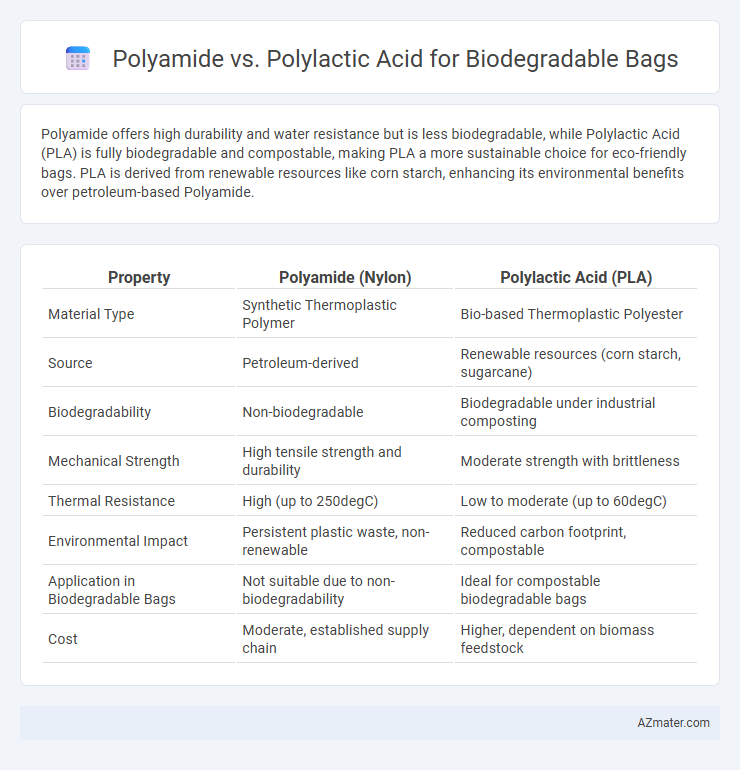Polyamide offers high durability and water resistance but is less biodegradable, while Polylactic Acid (PLA) is fully biodegradable and compostable, making PLA a more sustainable choice for eco-friendly bags. PLA is derived from renewable resources like corn starch, enhancing its environmental benefits over petroleum-based Polyamide.
Table of Comparison
| Property | Polyamide (Nylon) | Polylactic Acid (PLA) |
|---|---|---|
| Material Type | Synthetic Thermoplastic Polymer | Bio-based Thermoplastic Polyester |
| Source | Petroleum-derived | Renewable resources (corn starch, sugarcane) |
| Biodegradability | Non-biodegradable | Biodegradable under industrial composting |
| Mechanical Strength | High tensile strength and durability | Moderate strength with brittleness |
| Thermal Resistance | High (up to 250degC) | Low to moderate (up to 60degC) |
| Environmental Impact | Persistent plastic waste, non-renewable | Reduced carbon footprint, compostable |
| Application in Biodegradable Bags | Not suitable due to non-biodegradability | Ideal for compostable biodegradable bags |
| Cost | Moderate, established supply chain | Higher, dependent on biomass feedstock |
Introduction to Biodegradable Bags: Polyamide vs Polylactic Acid
Biodegradable bags are increasingly developed using polyamide and polylactic acid (PLA) due to their environmentally friendly properties. Polyamide offers superior strength and durability, making it suitable for heavy-duty applications, while PLA is derived from renewable resources like corn starch, providing easier composting and degradation in natural environments. Comparing their biodegradability rates, PLA typically decomposes faster under industrial composting conditions, whereas polyamide requires more specific biodegradation settings.
Chemical Structure: Polyamide and Polylactic Acid Compared
Polyamide, a synthetic polymer composed of repeating amide linkages, offers strong hydrogen bonding due to its nitrogen and oxygen atoms, resulting in high tensile strength and thermal stability. Polylactic Acid (PLA), derived from renewable lactic acid monomers, features ester linkages in its chemical structure, promoting biodegradability through hydrolysis under composting conditions. The primary difference in their chemical structures--amide bonds in polyamides versus ester bonds in PLA--dictates their mechanical properties and environmental degradation profiles, influencing their suitability for biodegradable bag applications.
Manufacturing Processes of Polyamide and Polylactic Acid Bags
Polyamide bags are manufactured through a melting and extrusion process followed by biaxial orientation, which enhances strength and durability, making them suitable for reusable applications. Polylactic Acid (PLA) bags undergo a fermentation process converting renewable resources like corn starch into lactic acid, which is then polymerized into PLA resin and cast or blown into thin films. The manufacturing of PLA bags generally requires lower energy compared to polyamide, and the process emphasizes the use of biobased materials to ensure biodegradability and environmental sustainability.
Biodegradability Performance: Polyamide vs Polylactic Acid
Polylactic Acid (PLA) demonstrates superior biodegradability compared to Polyamide, breaking down efficiently under industrial composting conditions within 6 to 12 months. Polyamide, although offering strong mechanical properties, is less biodegradable and can persist in the environment for years without significant degradation. The inherent chemical structure of PLA, derived from renewable resources, facilitates microbial digestion, making it a preferred choice for eco-friendly biodegradable bags.
Environmental Impact Assessment
Polyamide bags biodegrade slowly due to their synthetic polymers, contributing to long-term environmental persistence and microplastic pollution. Polylactic acid (PLA) bags, derived from renewable resources like corn starch, offer a lower carbon footprint and decompose more rapidly under industrial composting conditions. Life cycle assessments indicate PLA bags significantly reduce greenhouse gas emissions and reliance on fossil fuels compared to polyamide alternatives.
Mechanical and Physical Properties Compared
Polyamide exhibits superior mechanical strength, elasticity, and thermal resistance compared to polylactic acid (PLA), making it more suitable for applications requiring durability and repeated use. PLA, derived from renewable resources, offers excellent biodegradability and stiffness but tends to be more brittle with lower impact resistance and tensile strength than polyamide. Both materials provide eco-friendly alternatives for biodegradable bags, yet the choice depends on balancing mechanical performance and environmental degradation rates.
Cost Analysis: Polyamide and Polylactic Acid Bags
Polyamide bags generally have higher production costs due to energy-intensive manufacturing and reliance on petroleum-based raw materials, making them less cost-effective for large-scale biodegradable bag production. Polylactic Acid (PLA) bags, derived from renewable resources like corn starch, exhibit lower raw material expenses and faster processing times, resulting in more competitive pricing within the biodegradable market. Cost analysis shows PLA bags offer better scalability and economic advantages, particularly as biopolymer technologies advance and production volumes increase.
Applications in Packaging and Beyond
Polyamide (PA) offers excellent mechanical strength and barrier properties, making it suitable for durable, moisture-resistant packaging applications such as food wraps and heavy-duty bags. Polylactic Acid (PLA), derived from renewable resources, excels in compostability and transparency, ideal for short-term use items like biodegradable shopping bags and disposable packaging. Beyond packaging, PA is used in automotive and textile industries for durability, while PLA finds applications in medical implants and 3D printing due to its biocompatibility and environmental benefits.
Consumer Safety and Regulatory Considerations
Polyamide and Polylactic Acid (PLA) differ significantly in consumer safety and regulatory compliance for biodegradable bags. PLA is derived from renewable resources and is generally recognized as safe (GRAS) by the FDA, promoting lower toxicity and safer disposal, while polyamide's synthetic nature may raise concerns over chemical residues and slower biodegradation rates. Regulatory agencies often favor PLA-based bags due to their stringent environmental certifications and reduced risk of harmful microplastic formation, ensuring higher consumer safety standards.
Future Prospects and Industry Trends
Polyamide offers durability and mechanical strength, making it suitable for reusable biodegradable bags, while polylactic acid (PLA) excels in compostability and environmental compatibility, driving its adoption in single-use packaging. Industry trends indicate a shift towards PLA due to increasing regulatory pressure and consumer demand for fully compostable products, supported by advancements in PLA production reducing costs and enhancing performance. Future prospects highlight hybrid materials combining polyamide and PLA to balance strength and biodegradability, fostering innovation in sustainable packaging solutions.

Infographic: Polyamide vs Polylactic Acid for Biodegradable Bag
 azmater.com
azmater.com